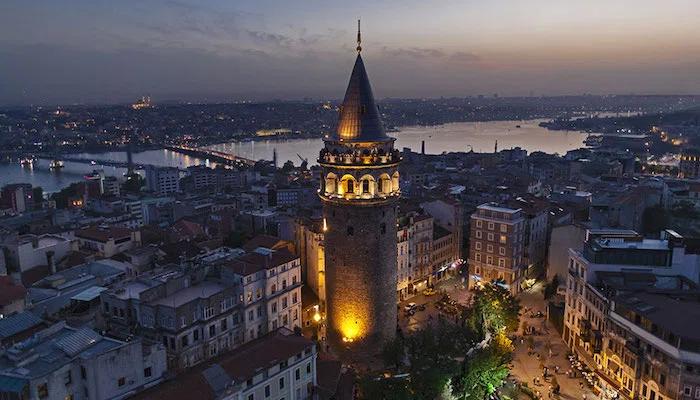Galata Tower Galata Tower Museum, also known as Galata Tower or Galata Tower Museum after it began to be used as a museum, is a tower located in Beyoğlu district of Istanbul, Turkey. It takes its name from the Galata district where it is located. The tower, which was built as a watchtower within the walls of Galata, is currently used as an exhibition space and museum. It is one of the symbol structures of both Beyoğlu and Istanbul.
In 1267, the Genoese, who were in alliance with the Byzantine Empire, established a colony called "Pera" in Galata, located north of the Golden Horn, and expanded the area of dominance of this colony with permits issued by Byzantium over time. The tower, which was called the "Tower of the Holy Cross" (Turris Sancte Decis) at that time because of the cross on its top, was also built as part of the fortifications built in the region between 1335 and 1349 by increasing the area of dominance towards the hill in a northeast direction contrary to these permits. The war that broke out dec the two states that year ended with a treaty signed the following year, while the hill on which the tower was located was left to Genoese control. After the capture of Constantinople by the Ottoman Empire on May 29, 1453, the Genoese in Pera ceded the colony to the Ottomans without any conflict. Although some destruction was carried out on the fortifications in Galata, including the tower, the Ottoman Sultan II. By Mehmed's edict, the destruction of the tower was stopped and the destroyed parts were rebuilt. the tower was damaged by an earthquake in 1509 and was repaired as of 1510. 16. and 17. in the centuries, the place of holding prisoners of war and the quartermaster's warehouse, 18. as of the XII century, it was used as a fire tower by Mehterhane January and fire observers.
during the repair work after the fire in 1794, the design of the tower was changed, while the upper part was converted into a coffee house. after the fire in 1831, its design was changed once again. after its roof toppled over in a storm in 1875, two wooden floors of masonry were built on the top floor and this part was used to observe and report fires in the city. With the restoration work between 1965 and 1967, the tower was organized as a tourist structure, the floors of which served different purposes, and the roof of the tower was renovated similarly to the design between 1832 and 1876. dec Dec. During this period, it was leased from the Istanbul Municipality and started to be operated by the company owned by the Ünal Brothers and their heirs in the following period. in 1999-2000, a restoration was carried out on its exterior. in 2013, BELTUR, which is affiliated to the Istanbul Metropolitan Municipality, took over the operation. During this period, a cafe and a restaurant were located on the top two floors of the tower. In the same year, it was included in the Temporary List of World Heritage Sites in Turkey by UNESCO. in 2019, its ownership and operation passed to the General Directorate of Foundations. after the works carried out in 2020, the tower was organized and started to be used as a museum and exhibition venue.
The cylindrical body of the Romanesque-style masonry tower, whose height to the tip of the roof is 62.59 m, is made of stone. It has 11 floors, including one basement, ground and mezzanine. There is an elevator between the ground floor and the sixth floor, while there are stone stairs from the dec floor to the fourth floor and steel construction stairs from the sixth floor to the eighth floor. The cone-shaped roof covering its top is reinforced concrete. Currently, the ground floor of the tower serves as a ticket control and security point, while the entrance to the elevator, which reaches up to the sixth floor, is located here. On the first floor in the museum store, while the next three times, respectively, Hezarfen Ahmed Çelebi's galat floats in conjunction with a screen that shows an animation of the simulation from the tower area of the tower with the issue of Taqi used by the works of the period; of the independence war photos; Galat tower and fortification information and artifacts; galat tower and Istanbul-related works of a permanent museum and exhibition areas. The seventh floor, which is a temporary exhibition space after the sixth floor, which is a transition area, has a model showing a part of Istanbul and navigation binoculars placed in front of windows, while the eighth floor is arranged as a viewing terrace. The exterior of the tower and the area surrounding the tower are used for awareness initiatives, commemoration or celebration on some special days.

